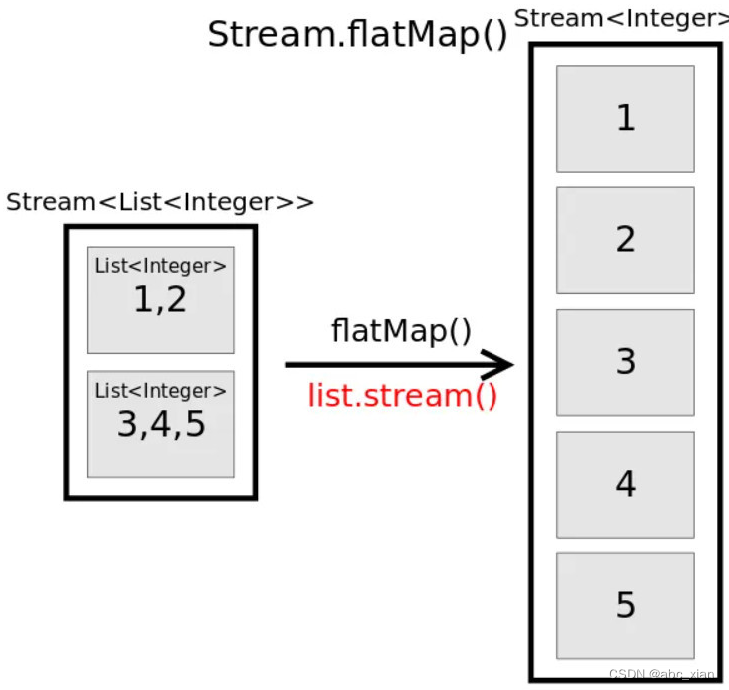一、flatMap:接收一个函数作为参数,将流中的每个值都换成另一个流,然后把所有流连接成一个流。
将多个列表合并成一个大的列表,可用来优化嵌套循环问题

两层嵌套
public class Test{
@Data
@Builder
@AllArgsConstructor
@NoArgsConstructor
public static class W{
public String name;
public List<M> listM;
}
@Data
@Builder
@AllArgsConstructor
@NoArgsConstructor
public static class M{
public String name;
public List<String> con;
}
public static void main(String[] args) {
M m1 = M .builder().name("m1").con(Arrays.asList("m1-1","m1-2")).build();
M m2 = M .builder().name("m2").con(Arrays.asList("m2-1","m2-2")).build();
M m3 = M .builder().name("m3").con(Arrays.asList("m3-1","m3-2")).build();
M m4 = M .builder().name("m4").con(Arrays.asList("m4-1","m4-2")).build();
W w = W.builder().name("w").listM(Arrays.asList(m1,m2,m3,m4)).build();
List<String> collect = w.getListM().stream().flatMap(e -> e.getCon().stream()).collect(Collectors.toList());
System.out.println(collect);
}
}输出
[m1-1, m1-2, m2-1, m2-2, m3-1, m3-2, m4-1, m4-2]三层嵌套
public class Test {
@Data
@Builder
@AllArgsConstructor
@NoArgsConstructor
public static class W{
public String name;
public List<M> listM;
}
@Data
@Builder
@AllArgsConstructor
@NoArgsConstructor
public static class M{
public String name;
public List<N> listN;
}
@Data
@Builder
@AllArgsConstructor
@NoArgsConstructor
public static class N{
public String name;
public List<String> con;
}
public static void main(String[] args) {
N n1 = N.builder().name("n1").con(Arrays.asList("n1-1","n1-2")).build();
N n2 = N.builder().name("n2").con(Arrays.asList("n2-1","n2-2")).build();
N n3 = N.builder().name("n3").con(Arrays.asList("n3-1","n3-2")).build();
N n4 = N.builder().name("n4").con(Arrays.asList("n4-1","n4-2")).build();
M m1 = M.builder().name("M1").listN(Arrays.asList(n1,n2)).build();
M m2 = M.builder().name("M3").listN(Arrays.asList(n3,n4)).build();
W w = W.builder().name("w").listM(Arrays.asList(m1,m2)).build();
List<String> collect = w.getListM().stream().flatMap(e -> e.getListN().stream().flatMap(x->x.getCon().stream())).collect(Collectors.toList());
System.out.println(collect);
}
}输出
[n1-1, n1-2, n2-1, n2-2, n3-1, n3-2, n4-1, n4-2]内外层元素合成新的map(1)
Map<Long, String> idToNameMap = outList.stream()
.flatMap(e -> e.getInnerList().stream()
.map(p -> new AbstractMap.SimpleImmutableEntry<>(p.getId(), e.getName())))
.collect(Collectors.toMap(Map.Entry::getKey, Map.Entry::getValue, (v1, v2) -> v1));内外层元素合成新的map(2)
Map<Long, Map<String, Object>> idToNameSeqMap = outList.stream()
.flatMap(e -> e.getInnerList().stream()
.map(p -> {
Map<String, Object> map = new HashMap<>();
map.put("name", e.getName());
map.put("sequence", e.getSequence());
return new AbstractMap.SimpleImmutableEntry<>(p.getId(), map);
}))
.collect(Collectors.toMap(Map.Entry::getKey, Map.Entry::getValue, (v1, v2) -> v1));二、peek
修改List内部的数据,peek返回类型为void,map需要一个return
WorkManageVOS = WorkManageVOS.stream().peek(workManageVO -> {
List<WorkProcedureVO> filteredProcedures = workManageVO.getProcedures().stream()
.filter(procedureVO -> procedureVO.getTS().equals(Integer.parseInt(testPipe)))
.collect(Collectors.toList());
workManageVO.setProcedures(filteredProcedures);
}).collect(Collectors.toList());
//拿外层List的属性,放到内层List中
List<workProcedureVO> updatedProcedures = workManageVOS.stream()
.flatMap(workManageVO -> workManageVO.getProcedures().stream().peek(procedure->{
procedure.setModelCode(workManageVO.getModelCode());
procedure.setBatchCode(workManageVO.getBatchCode());
procedure.setSequence(workManageVO.getSequence());
})).collect(Collectors.toList());三、Collectors.toMap
//从List中提取两个属性,组成一个新的map
Map<Integer, String> collectPipes = list.stream()
.collect(Collectors.toMap(EncapsulationPipeVO::getPipeCode, EncapsulationPipeVO::getPipeName));
//从list每个实例中提取一个属性值做key,实例做value组成map
Map<Integer, String> collectPipes = list.stream()
.collect(Collectors.toMap(EncapsulationPipeVO::getPipeCode, Function.identity()));
四、Collectors.groupingBy
//从list每个实例中提取TM和Id,然后把id组装成List
Map<Integer, List<Long>> collectTmMaps = workProcedureVOS.stream().collect(Collectors.groupingBy(workProcedureVO::getTM,
Collectors.mapping(workProcedureVO::getId, Collectors.toList())));五、
//提取List中对象属性,组成map
List<WorkManageVO> WorkManageVOS = WorkManageService.searchAllVO(build);
// Filter the stream once and store the filtered list
List<WorkManageVO> filteredWorkManageVOS = WorkManageVOS.stream()
.filter(e -> e.getModelCode() != null)
.collect(Collectors.toList());
// modelCode -> batchCode Map
Map<String, List<String>> batchCodeMap = filteredWorkManageVOS.stream()
.collect(Collectors.groupingBy(WorkManageVO::getModelCode, Collectors.mapping(WorkManageVO::getBatchCode, Collectors.toList())));
//提取List中对象属性,组成map,加了去重
List<WorkManageVO> list = /* your List<WorkManageVO> instance */;
Map<String, List<String>> result = list.stream()
.collect(Collectors.groupingBy(WorkManageVO::getModelCode, Collectors.mapping(WorkManageVO::getBatchCode, Collectors.toSet())))
.entrySet().stream()
.collect(Collectors.toMap(Map.Entry::getKey, e -> new ArrayList<>(e.getValue())));
System.out.println(result);
///提取List中对象属性,组成map,加了去重,统计的是个数
List<WorkManageVO> list = /* your List<WorkManageVO> instance */;
Map<String, Long> result = list.stream()
.collect(Collectors.groupingBy(WorkManageVO::getModelCode, Collectors.mapping(WorkManageVO::getBatchCode, Collectors.toSet())))
.entrySet().stream()
.collect(Collectors.toMap(Map.Entry::getKey, e -> (long) e.getValue().size()));
System.out.println(result);六、
//
//modelCode -> ProjectId
Map<String, List<Long>> projectIdMap
//ProjectId -> EncapsulationId
Map<Long, List<Long>> encapsulationIdMap
//提取所有的EncapsulationId
List<Long> encapsulationIdList = projectIdMap.getOrDefault(modelCode, Collections.emptyList())
.stream()
.flatMap(item -> encapsulationIdMap.getOrDefault(item, Collections.emptyList()).stream())
.collect(Collectors.toList());





















 2万+
2万+











 被折叠的 条评论
为什么被折叠?
被折叠的 条评论
为什么被折叠?








